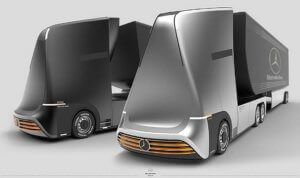What’s Next for the Logistics Industry?

Last month, orders for big rigs hit a record high. The trucking companies are beefing up their fleets to meet the increasing freight demand. Now, with the unemployment rates at an all-time low and going lower, and the resulting increase in labor rates, finding qualified drivers has become tougher than it has ever been. That, coupled with the current weight and length regulations as well as the bottlenecks of our highway infrastructure, what can the trucking industry do to meet the new overwhelming demand? More truck orders just aren’t going to be enough in the future. This makes me wonder what disruptive technologies and processes will be born to cope with these problems. Let’s look at a couple other economic and political stresses have stimulated innovation in other areas of industry and life.
Back in the 1980’s, manufacturers responded to global economic stresses by automating. Fewer people who were well paid, were able to work at more productive rates because they were operating techs who operated robotics rather than floor workers with assembly skills. This allowed domestic manufacturers to compete with ultra-low labor rates in third world countries and kept these manufacturers afloat. Problem solved…
Recently, global warming fears spurred innovation and proliferation of alternative energy sources and a paradigm shift in energy production and use. The global increase in solar panel orders has driven their cost down to affordable levels. Look at how Tesla, in response to the same problem, caused an industry trend where every large car manufacturer is now offering electric vehicles, which resulted in battery technology and their prices also going down. Volvo recently announced that it will be adding five fully electric vehicles to its lineup starting in 2021. Batteries are becoming more efficient, higher capacity, and cheaper. Problem solved…
Historically, the domestic trucking industry has had great lobbying success with allowing higher capacity rigs. In Spain, SEAT and Grupo Sesé have debut a 100’ long rig. In the southwest USA, trailers can be up to 57’. Everywhere you look, rigs have been getting wider, taller and longer. In Australia, the road trains have been a thing since the 19th century! A larger rig means increased the productivity and lowers emissions per cargo moved. I don’t see this trend slowing, and it may even accelerate. Even when product is shipped by rail, barge or ship, it is still loaded on trucks to the destination. They aren’t going away!
Where is the disruptive technology for the trucking industry?
Perhaps it will be self-driving rigs. After all, self-driving cars are commonplace today. I imagine the Coalition for Efficient and Responsible Trucking (CERT) has been lobbying hard for this behind the scenes. Tesla is taking orders for semi’s now! How far behind do you think self-driving rigs are? What if those rigs only moved late at night when people are home in bed? After all, a computer doesn’t get sleepy, and the roads are clear at 2AM.
Perhaps it will be more regional distribution centers (DC’s) rather than the mega facilities which started popping up a few decades ago. Goods could be stored in small to mid-sized, regional DC’s and delivered out locally rather than from larger centers of commerce. Nobody today has the patience or the time to wait, and this has the potential to eliminate the traffic jams by stockpiling product closer to its destination. Last mile deliveries and small to mid-sized DC’s may become as ubiquitous as Wal Mart’s in the future.
Perhaps it is something that hasn’t even been brought to the table yet. I remember when 3D printing was invented, and it was being touted as the answer to every problem. If you need something, you print it and viola. As crazy as that sounds, it is fundamentally possible, but it would still require the raw materials. I love Star Trek, but I don’t think replicators and transporters will happen in our lives. Maybe one day, we can just fold space and instantly bring goods into our space from anywhere. Better yet, take ourselves to that place and shop.
People are depending on logistics more and more, and I don’t see anything but more demand in the future. The population is growing and so is consumerism. One-click buying and next day delivery is a fundamental in today’s consumer paradigm. I am excited to see how logistics will evolve in the next 20 years. I do look forward to electric rigs and self-driving vehicles. I also look forward to regional warehouses and last mile deliveries as a standard rather than traffic jams of large semi’s coming from mega DC’s. I look forward to drone deliveries, but I do hope they can do something to quiet them down.
Adding more trucks is only a reactionary short-term measure to deal with the problems moving into the future. The logistics industry needs to be involved in innovation because the global economy depends on it. We all must work together and share information and technology to make the future of logistics flow smoothly and not look like a giant truck traffic jam on I-5 at rush hour.

